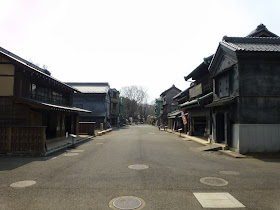Out in the far west reaches of Tokyo, beyond the city itself out into the suburbs, is a large park full of historic buildings from the Edo period. But, first, more plum blossoms.
I happened to visit when the plums were blooming, and I couldn't help but take a few photos.
Despite it being a Sunday, plum blossoms just aren't as popular as cherry blossoms, so there weren't many people taking photos. Besides, plums bloom when it's still somewhat cold outside. Who wants to spend time outdoors in the cold? Apparently I did.
Most of the buildings are from the Meiji period (1868-1912) and later, with some very elegant houses mixed in with everyday houses and commercial buildings.
Most of Tokyo's old buildings have been destroyed by fires, earthquakes, war, and progress. So several of them have been brought out to pasture and restored to their original glory.
You can go inside almost all the buildings. Japanese apartments may be small, but some of these houses are pretty nice
An old sink and ice box are still in the yellow house's kitchen.
What a nice dining room!
And that's a lovely formal living room.
Some buildings are fairly simple...
Others quite nice.
Art deco, anyone?
That's a photo studio, with equipment. Too bad you can't sit and take your portrait in front of the matte.
There are a few older vehicles. This is a bus - I think it was the first bus, or first school bus in Japan.
This house was being restored. It's open by now.
It was fun going in and out of all the old buildings.
A small shrine...
A police box...
There are several commercial buildings.
This is a nice large garden.
Here's the farm house.
An old streetcar, which you can board and sit in. But it doesn't go anywhere.
A small shopping street has several old stocked stores.
The buildings sometimes were pulled right from the block, seeming somewhat naked without their partners.
You can go inside the shops too, some of which have lessons, and others which function as stores.
Need some old stationery?
I think that's all nori (seaweed sheets) and other food.
Whisky!
There's a large bank vault, too.
At the end of the street is a large bathhouse. Let's go inside.
A nice mural adorns the wall. This is the view from the men's side, but you can see both sides and explore most of the rest of the building too. There isn't much to it anyway other than the bathing and changing areas.
Looking back down the shopping street from the bath house.
Next to the bathhouse is a small izakaya (bar). Too bad they aren't serving drinks here anymore.
There are many more buildings and exhibits to see (about 20 buildings total). One weekend a month, they have traditional crafts, and there are other special events throughout the month. The Tatemonoen (Edo-Tokyo Open Air Architectural Museum) English-language website isn't terribly informative other than the basics - details on admission fees, access, and hours, but for those just looking to visit it's enough.
Overall, I enjoyed the museum. It's not as good as Meiji Mura near Nagoya, but it is easily accessible from Tokyo. Then again, Meiji Mura is probably the best in Japan - the Historic Village of Hokkaido has as many buildings but Meiji Mura has really beautiful historic architecture.
You can visit Tuesday through Sunday from 9:30-5:30 (4:30 October through March). Admission is 400 yen. Access to the museum is through Hana-Koganei or Musashi-Koganei Stations, and then a bus; a long walk (25-30 minutes) from the train station is possible from Hana-Koganei, Musashi-Koganei or Higashi-Koganei Stations.

































No comments:
Post a Comment